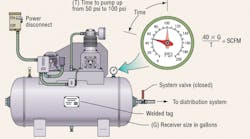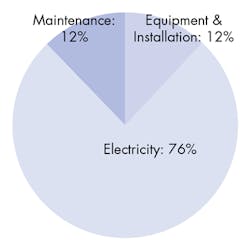This file type includes high resolution graphics and schematics when applicable.
Most industrial facilities need some form of compressed air, whether for running a simple air tool or for more complicated tasks such as operation of pneumatic controls. A survey by the U.S. Department of Energy (DOE) showed that for a typical industrial facility, approximately 10% of the electricity consumed is for generating compressed air.
For some facilities, compressed-air generation may account for 30% or more of the electricity consumed. Compressed air is an on-site generated utility. Very often the cost of generation is not known; however, some companies use a value of 30 cents to 50 cents per 1,000 cubic feet of air.
Compressed air is one of the most expensive sources of energy in a plant. The overall efficiency of a typical compressed air system can be as low as 10% to 15%. For example, to operate a 1-hp air motor at 100 psig, approximately 7 to 8 hp of electrical power is supplied to the air compressor.
To calculate the cost of compressed air in your facility, use the following formula:
where hpb = compressor shaft horsepower (frequently higher than the motor nameplate horsepower—check equipment specification),
Percent time = percentage of time running at this operating level,
Percent full-load hpb = hpb as percentage of full-load hpb at this operating level, and
Motor efficiency = Efficiency of the electric motor at this operating level.
Example
A typical manufacturing facility has a 200 hp compressor (which requires 215 hpb) that operates for 6,800 hr annually. It is fully loaded 85% of the time (motor efficiency is 95%) and unloaded the rest of the time (25% full-load hpb and motor efficiency is 90%). The aggregate electric rate is $0.10/kWhr.
Cost when fully loaded:
Cost when partially loaded:
Annual energy cost = $97,584 + $4,544 = $102,128
For additional information on industrial energy efficiency measures, visit www.energy.gov/eere/amo/compressed-air-systems.






